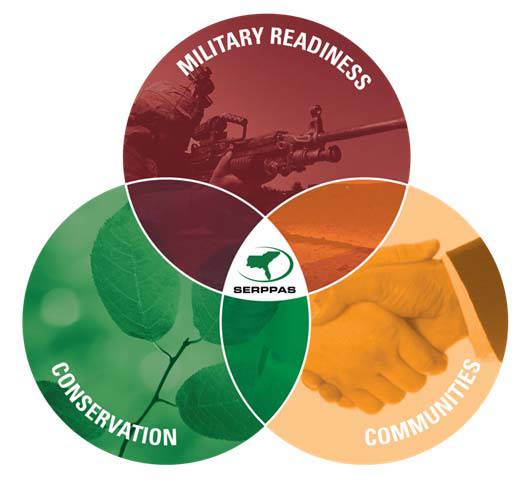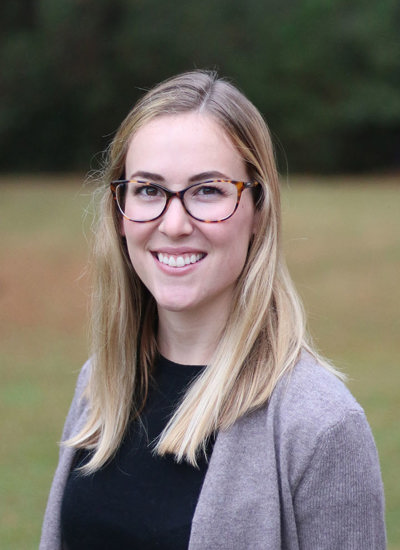- Home >
- About Us
About Us
Purpose
Department of Defense training space, places where soldiers, sailors, Marines, and airmen prepare for the complexities and challenges of warfare, are critical to our Nation’s defense. ‘We train as we fight because we fight as we train’ is the motto, and this pledge represents a solemn and sacred commitment to prepare and equip our warfighters before sending them into battle. Training space and the natural environment inherent to that landscape is the ‘classroom’ for learning critical skills and battle techniques in the conditions warfighters might expect on actual battlefields. Preserving these critical landscapes for their intended training and test missions directly supports our warfighters and the national defense mission.
There are many forces that can impact the natural landscapes where these critical training and testing missions take place. Rapid population growth in the Southeastern United States and the conversion of land into developed communities has resulted in the loss of agricultural land, critical wildlife habitats, and working landscapes such as farms, forests, and fisheries. The loss of these land uses increases encroachment on military installations, hindering the military's ability to train effectively. As a result, it becomes essential to preserve compatible land uses and natural habitats near military installations to remove and avoid land use conflicts, reduce regulatory restrictions and sustain open and natural landscapes to enable key mission capabilities.

State environmental and natural resource officials from across the Southeast partnered with the Department of Defense (DoD) and other federal agencies to form the Southeast Regional Partnership for Planning and Sustainability (SERPPAS) in response to growing challenges in the Southeast. SERPPAS works to prevent encroachment around military lands, encourage compatible resource-use decisions, and improve coordination among regions, states, communities, and military services.
Vision and Mission
The mission of SERPPAS is to seize opportunities and solve problems in value-adding ways that provide mutual and multiple benefits to the partners, sustain the individual and collective missions of partner organizations, and secure the future for all partners, the region, and the nation.
The vision of SERPPAS is a partnership of Southeastern state, military and federal agencies working together to sustain and advance national defense through land and resource conservation in support of the communities and economies that depend on them.
History
It was 2005 in the Southeast United States. The population was growing rapidly, urban areas were sprawling, military missions were becoming more complex, and there was intensifying and accelerating competition for increasingly scarce resources such as water, land, and air space. The realization that these forces previously resulted, and would continue to result, in the loss of agricultural land, critical wildlife habitats, and working landscapes such as farms, forests, and fisheries became more apparent than ever. These same forces were causing increasing encroachment on military facilities, installations, and ranges supporting our National Defense testing and training operations and inhibiting their ability to maintain military readiness. Increasing development pressures were threatening to leave military installations as some of the last large, undeveloped, and biodiverse stretches of land and ecosystems in the region and presented incredible challenges to the sustainability of defense, natural, and economic resources throughout the Southeast.
These competitions were emphasized by major conflicts occurring at the time in North Carolina between the military, the state, and conservation groups including the “Woodpecker Wars” at Fort Bragg and the potential siting of a Navy outlying landing field adjacent to a wildlife reserve for migratory birds. These conflicts, along with the other pressures in the region, demonstrated the fact that what happens “beyond the fence line” is critical in the ability for military installations to carry out their mission inside the fence line. This military encroachment came in many forms, from habitat loss to urban development to and required the installation to work with partners outside the boundary of their installation. What became most clear was that there was no forum for these interests and partners to realize their common challenges and mutual interests and potentially avoid conflicts before they happen.
The collective recognition that long-term sustainability of national defense and the lands and resources that support it crosses geographic and organizational boundaries became an essential driver for partners across the Southeast to work collaboratively. The Southeast Regional Partnership for Planning and Sustainability was created to serve as that forum and continues to sustain and advance national defense through land and resource conservation in support of the communities and economies that depend on them.
Organization
SERPPAS is organized to encourage open communication, build effective working relationships, and identify opportunities for mutual gain. The below diagram outlines that structure including the roles and responsibilities for each level of participation.
Values
SERPPAS is driven by collaborative leadership and each partner strives to identify and seize opportunities for mutual gain, to deal well with differences, and to solve complex problems. No partner is asked to compromise their mission for the mission of others. The below values, continuously practiced by all, ensure a truly collaborative and successful partnership.
To be a good SERPPAS partner, each will strive to:
- Balance emotion with reason
- Understand each other’s interests
- Communicate openly and effectively
- Consult before deciding
- Use persuasion rather than coercion
- Accept each other as someone worth dealing with
- Be easy on the people, hard on the issues
- Focus on interests, not positions
As a Partnership, SERPPAS strives to:
- Build effective working relationships that yield trust and progress
- Tap the power of a good map
- Invent options for mutual gain
- Tap the power of partnership, and move the evolution of SERPPAS cooperation to another level and scale
- Tap the power of leadership
- Tap the power of innovation
Coordinator

As the SERPPAS Coordinator, Addie Thornton provides management for the strategic planning, execution and operation of the Southeast Regional Partnership for Planning and Sustainability (SERPPAS) and its associated efforts. Addie prepares key and timely information regarding SERPPAS efforts and potential decision points to leadership in and outside of SERPPAS, manages the technical and administrative support of all aspects of the partnership, coordinates with partners (local, State and Federal entities) on strategic priorities, monitors progress, and develops, fact sheets, website content and other briefings materials. Previously, Addie served as the Program Coordinator for the Forestry & Environmental Outreach Program (FEOP) in the College of Natural Resources at NC State University. In this role, she coordinated a variety of natural resource trainings, workshops and conferences across the Southeast.
Addie graduated with her Bachelor's and Master's from North Carolina State University. She is located in Raleigh, North Carolina, with her husband, Avery, and sons, Calvin and Silas.
